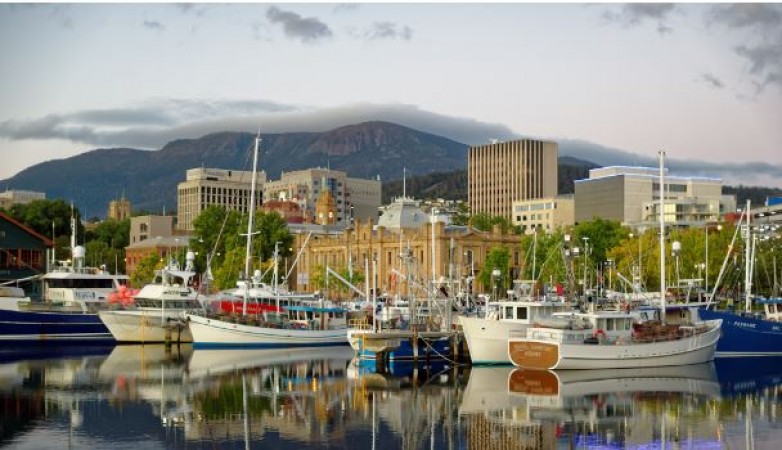
Hobart, the charming capital of Tasmania, Australia's island state, is a city steeped in history, surrounded by natural beauty, and brimming with vibrant culture. Situated on the southeastern coast of the island, Hobart is nestled between the picturesque Mount Wellington and the stunning waters of the Derwent River. With a population of around 240,000, Hobart strikes a perfect balance between a thriving modern metropolis and a serene haven for nature lovers.
Hobart's history can be traced back to 1804 when it was established as a British penal colony. The city's colonial heritage is still evident today through its well-preserved historic buildings and architectural landmarks. One such landmark is the Salamanca Place, a picturesque row of sandstone warehouses dating back to the 1830s, now home to galleries, boutiques, and lively restaurants. The iconic Georgian-style buildings, such as the Hobart Town Hall and the Customs House, add to the city's old-world charm and are a testament to its rich past.
Also Read: Newcastle, Australia a Coastal Gem of History, Industry, and Culture
Another integral part of Hobart's history is the maritime influence, as it has always been a significant port city. The Tasmanian Museum and Art Gallery houses a vast collection of artifacts and exhibits dedicated to the exploration of Tasmania's maritime history, indigenous culture, and natural sciences. The Maritime Museum of Tasmania, located at the waterfront, offers visitor’s insights into the seafaring heritage and the stories of voyages to the Southern Ocean and Antarctica.
Hobart's scenic beauty is unparalleled. Mount Wellington, standing tall at 1,271 meters (4,170 feet) above sea level, offers breathtaking panoramic views of the city, the river, and the surrounding landscapes. The drive to the summit is a popular tourist activity, providing access to stunning lookout points and hiking trails for nature enthusiasts. In the colder months, the mountain is often sprinkled with snow, transforming it into a winter wonderland.
Also Read: Gold Coast, Queenland: Emerges as Top Tourist Destination
The Derwent River plays a central role in Hobart's landscape, providing a picturesque backdrop and numerous recreational opportunities. The waterfront precinct offers a perfect blend of historical sites, contemporary architecture, and recreational spaces. Visitors can stroll along the Elizabeth Street Pier, enjoying the views of sailing boats and yachts, or take a harbor cruise to explore the river's beauty.
One of Hobart's most celebrated events is the Taste of Tasmania festival, held annually around New Year's Eve on the waterfront. This food and beverage extravaganza showcases Tasmania's finest produce, wines, and craft beers. It brings together locals and visitors alike to celebrate the region's culinary delights, fostering a sense of community and pride in the local fare.
Also Read: Malibu, California: A Coastal Gem of Endless Beauty and Celestial Appeal
The vibrant cultural scene in Hobart is evident through its various museums, galleries, and theaters. The Tasmanian Symphony Orchestra and the Theatre Royal contribute to the city's cultural tapestry by hosting world-class performances, concerts, and theatrical productions. The MONA (Museum of Old and New Art) has become an iconic attraction, housing an eclectic collection of contemporary and ancient art, making it one of the largest privately funded museums in the Southern Hemisphere.
The Salamanca Arts Centre is a hub for the city's creative community, offering studio spaces, galleries, and workshops. Every Saturday, the Salamanca Market draws locals and tourists alike, offering a diverse range of arts, crafts, and local produce. This vibrant market has become an integral part of Hobart's cultural identity, showcasing the creativity and talent of the region.
Also Read: Weifang: Exploring the Enchanting City of Kites
As a city that values its natural environment, Hobart has embraced sustainability and eco-tourism. The Royal Tasmanian Botanical Gardens, established in 1818, is a testament to the city's dedication to preserving its natural heritage. The gardens boast a diverse range of plant species, including the famous Wollemi pine, considered a "living fossil" as it was thought to be extinct until its discovery in 1994.
Hobart's commitment to sustainability is further demonstrated through its efforts to promote renewable energy and reduce carbon emissions. The city has been at the forefront of Australia's efforts to combat climate change, with initiatives like the "Tasmanian Energy Strategy" focusing on clean energy sources and reducing the ecological footprint.
Also Read: Dura-Europos Church: Unearthing Ancient Christianity
Hobart's modern development is also evident in its education and research institutions. The University of Tasmania, established in 1890, is one of Australia's oldest universities and contributes significantly to research in fields like marine and Antarctic studies, environmental sciences, and tourism.
Hobart has also seen an influx of tech start-ups and innovation hubs, further diversifying its economic landscape. The city's business district, centered around the Elizabeth Street Mall, is a bustling hub of activity, with a mix of traditional businesses and modern ventures.
Hobart's culinary scene has also evolved, with a burgeoning number of restaurants and cafes offering diverse cuisines and celebrating Tasmania's fresh produce. The city has become a foodie haven, attracting visitors with its innovative dishes and dedication to using locally sourced ingredients.
Also Read: Archaeologists Unearth New Discoveries at the Ancient Temple of Bel in Dura-Europos
Hobart, Australia, is a city that seamlessly weaves together its rich history, stunning natural beauty, vibrant culture, and modern developments. From its colonial heritage and maritime legacy to its breathtaking landscapes and thriving arts scene, Hobart offers a unique and enriching experience for both residents and visitors. Whether you're exploring the historic sites, immersing yourself in the arts, or enjoying the natural wonders, Hobart's allure will captivate you, leaving you with lasting memories of this charming and inviting capital city.